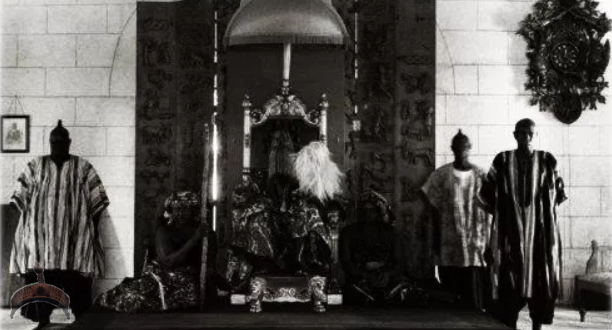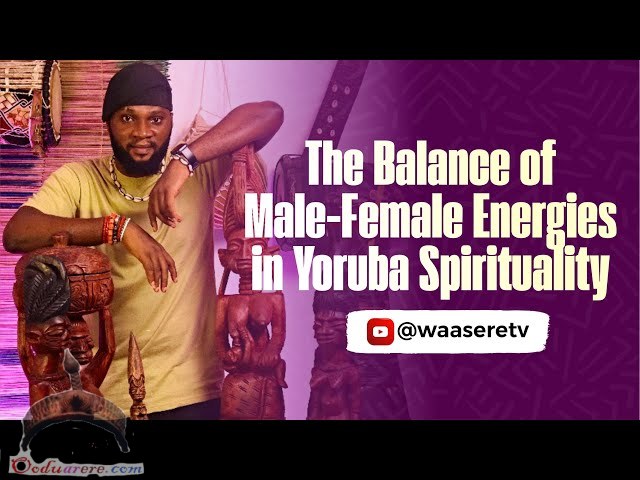In 1817, Afonja of Morin was the Are-Ona Kakanfo – the Head of the Army of the Oyo Empire, under the Alaafin of Oyo – Aole (The King). That year, Afonja sent an empty calabash to the Alaafin Aole, thereby signifying that he no longer acknowledged the authority of the Alaafin. Aole had no choice but to accept and in the traditional fashion, he committed suicide, but not before the Alaafin Aole uttered his famous curse on the Yorubaland recorded by Samuel Johnson at page 192 of his “History of the Yorubas”, 1921.
From Alaafin’s palace forecourt, Aole shot three arrows, one to the north, one to the south, and one to the west, saying:
“My curse be on you for your disloyalty and disobedience, so let your children disobey you. If you send them on an errand, let them never return to bring you word again. To all the points I shot my arrows will you be carried as slaves. My curse will carry you to the sea and beyond the seas, slaves will rule over you, and you, their masters, will become slaves.” Then, smashing an earthenware dish, he shouted, `Broken calabash can be mended, but not a broken dish; so let my words be irrevocable.”
The curse seemed to take immediate effect and there had been neither unity nor peace in Yorubaland from then till today.
The Oyo Empire flourished for over three hundred years. Professor I.A. Akinjogbin, the emeritus Professor of History put the situation as follows:
“Up to about 1780, the Oyo Empire remained at the peak of its military strength. Its economy was strong, its external trade in slave export unfortunately expanding, its industries functioning and its craftsmen confident and proud of their workmanship. There were quarrels between the ruling classes as to who would have a greater share of this growing wealth; with the successive Alaafin, apparently on one side, and the chiefs, led by the various Basorun of the period, on the other side. Each side attempted to draw in the ordinary citizens, presenting itself as their champion but it is doubtful whether the common people saw any difference between one group and another. In any case, the quarrels were always fought within the constitutionally laid down procedures – the chiefs would say that the king had been rejected, and the king would meekly take his own life after which a new king, from the same royal family, would be installed. Some times the Alaafin would use his prerogative to choose a Basorun, that he thinks would be more friendly towards him, only to discover that between one Basorun and another, there was no difference in their relationship with the Alaafin. The point being made is that, inspite of all these events, the economic conditions within the empire were good, life was safe, trade routes ran in all directions, some citizens were indeed noted to be fabulously rich and some of the Alaafin embarked on prestige projects.”
1793 – 1893 were the darkest years in the history of Yorubaland. Two things, according to Professor Akinjogbin, happened between 1816 and 1824, which irrevocably changed the history and fortunes of the Yorubaland. First, in 1816, the jihad, which had been raging in the Hausa Kingdoms since 1804 was extended to NUPE (Tapa) next door to Yorubaland and the newly converted Nupe lost no time in declaring war against the Akoko and Akoko-Edo in eastern Yorubaland. Second, Afonja in 1817 invited Alimi, the Muslim itinerant preacher to Ilorin. The Professor put the sequence of events as follows:
“Afonja in 1817 invited Alimi, the Fulani itinerant Muslim preacher to Ilorin. Alimi was not new in Yorubaland, for from about 1813, he had been going round such northern Yoruba large towns as far as Ikoyi and Ogbomoso. He had lived for three years in Kuwo, Solagberu’s town, and was intending to settle there when Afonja heard of him and decided to invite him to Bolin. He must therefore be presumed to have known Yorubaland fairly well and also to have been conversant with the on-going Fulani jihad. Afonja was not a Muslim and the invitation could have been conceived solely as a means of strengthening his military might with the charms that the Muslim preacher was expected to prepare. However, for Solagberu, who had earlier been invited by Afonja also from Kuwo and who might have known Alimi there, Alimi’s arrival could be seen as an important addition to his jama’a at Oke-Suna. There is indeed a distinct probability that Solagberu might have influenced Afonja’s invitation of Alimi to Morin, although the aim is not clear.”
“A number of discerning citizens clearly saw the danger in the new scenario, but so afraid of Afonja were most of them that they did not dare to tell him. Two persons however took courage. The first was Fagbohun, the Commander of the left flank of Afonja’s army, who thereby incurred his wrath and had to flee to avoid being executed. The second person was Agborin, Afonja’s younger brother, but so confident was Afonja of his own ability that he again brushed the warning aside. Frustrated, Agborin committed suicide.”
After dan Fodio was proclaimed Commander of the Faithful he swore to the disinterestedness of his intentions, saying:
“If I fight this battle that I may become greater than my fellow or that my son may become greater than his son, or that my slave may lord it over his slave, may the Kabbir (infidel) wipe us from the land.”
There was no imperial army and no central bureaucracy. Islam was the cement.
Alimi died about 1823. Afonja was Alimi’s benefactor but that did not stop Abdulsalam, Alimi’s successor, from overthrowing and usurping Afonja’s rights. According to Johnson’s History of the Yoruba, Abdulsalam became the ruler of Ilorin and heir of the whole of the Igbomina and what is now known as Oshun (Epo) area which Afonja had kept under his authority since 1797. Thus those who had led the rebellion, according to Professor Akinjogbin, finally lost the revolution. Abdulsalam sent for a jihadist’s flag from Sokoto which he served as Emir of Yoruba, under the Emirate of Gwandu and according to Johnson’s History, he then declared a Jihad against the whole of Yorubaland.
A new Oyo was established in the present site by Alaafin Atiba in 1837. Johnson recorded three attempts up to 1831 to retake Ilorin from the Fulanis. The first was the Ogele War, the second was the Mugbamugba War and the third was the Kanla war. About 1836, Oyo Ile, the original imperial capital was abandoned. But it is still today part of the Oyo State.
Each of the war was lost by the Yoruba largely because of what Johnson called: “the want of foresight and vaulting ambition of the rulers”. Professor Akinjogbin agrees with Johnson and is amazed how in the face of the danger which they all saw, the leaders kept thinking in terms only of their own selfish interest or their own importance and could not combine to fight a common enemy. Johnson on page 197 – 222 and R. Lawrence in his “The Oyo Empire” PP. 284 – 299, give many instances of these changing affiances, quarrels among the Yoruba leaders and the consummate political game of the Fulani rulers of florin. Karl Maier in his “This House Has Fallen” at P. 232 – 233 put it bluntly:
“Internal divisions have often opened the door to external manipulation. Such divisiveness dates at least to the demise of the old Oyo empire at the beginning of the nineteenth century. By the early nineteenth century, Oyo was facing pressure from the Fulanis in the north and from the Dahomey kingdom to the west (in modern-day Benin). Dahomey’s powerful slave-trading king, Gezo, fielded imposing armies led by thousands of female warriors. The power of the king of Oyo, the Alafin, collapsed when his army commander, Afonja, rebelled and captured the town of florin with the support of the Fulanis pushing south on their Islamic jihad. Afonja’s revolt convinced Yoruba provincial kings to the south that they too could rebel. For the rest of the century Yoruba land was beset by nearly continuous civil conflict that degenerated into slave-raiding wars. For a good part of the nineteenth century Yorubas sold Yorubas into bondage. If they had united, they probably could have defeated the Fulanis and retaken Ilorin, but they opted to fight each other instead. The wars only came to an end when the British governor of the Lagos Protectorate, Sir Gilbert Carter, used a combination of diplomacy and military muscle to force a pan-Yoruba peace treaty. The legacy of those wars has continued until today.- – – -”
The struggle in South Africa started in 1897 and they only released Mandela from prison in 1992.
The Ibadan Wars: Fulanis Defeated in Oshogbo
First, Ibadan was founded in 1828 – 1835 by brave and tested soldiers. During the same period, roaming Oyo soldiers occupied Ijaiye under Dado and Kurunmi. Alaafin Atiba founded New Oyo (Ago-Oja) in 1837. These leaders saw their mission as continuing the war of resistance against the Fulani until the last were completely driven out of Yorubaland. Alaafin Atiba shared their determination and resuscitated old titles and bestowed them on the rulers of the new towns. Kurunmi of Ijaiye became the Aare-Ona-Kakanfo with responsibility to defend the western part of the old Oyo Empire against threats from Gezo, the King of Dahomey. Oluyole of Ibadan was so successful that the Fulani army was defeated in 1840 in Oshogbo thereby recovering some of the lost Yoruba towns. It was morale boosting. The victory encouraged the Ekitis to invite the Ibadan to help them drive out the Fulanis from Ilorin who had been threatening Osi, Otun, Aisegba, Ikole and Itaji. The Ibadan acceptance led to the Ibadan expansionist wars as stated by S.A. Akintoye in his “Revolution and Power Politics.”
The Ibadan Empire
The Ibadan Expansionist Wars took place between 1840 – 1878. Emeritus Professor Akinjogbin in his “Wars in Yorubaland, 1793 – 1893: An analytical categorisation” puts it thus:
“By 1865, Ibadan had grown to become the strongest political force in Yorubaland. In those 25 years, virtually all the Oyo speaking areas, the Ife Kingdom, the Ijesha Kingdom, the whole of Ekiti,Akoko and Yagbe, came under what has been called The Ibadan Empire from which the Fulani invaders had been driven out”.
So successful was Ibadan that the Ijebu Kingdom and the Ebga State constantly suspected, not without reason, that Ibadan might want to take them over as well and become “Master of the whole world”. What an hyperbole!
How the Ibadan Empire, which for all practical purposes succeeded the defunct Oyo Empire, has been scholarly traced in three works: Samuel Johnson: History of the Yorubas, J.F. Ade Ajayi and R. Smith: Yoruba Warfare and Professor Bolanle Awe: Oxford PH.D. thesis (1964) – “The Rise of the Ibadan Empire”.
The leaders of Ibadan during these era, stemming the Fulani calvary drive and their expansionist onslaught, were Oluyole (Bashorun). Ibikunle, the (Balogun); Oderinlo, (the Balogun); Ogunmola; (the Otun); and Oshundina, (the Osi).
The Ijaiye War fought between 1859 – 1862 could rightly be classified in effect, as part of the Ibadan expansionist wars. Kurunmi of Ijaiye was the Are-Ona-Kakanfo – the Commander of the Army of the Oyo Empire.
The Ijaiye War was fought on two major issues. First, Adelu’s succession after Atiba in 1858 was supported by Ibadan but opposed by Kurunmi. Second, the issue of giving the Alaafin more territory to increase his income, particularly in Oke-Ogun to which Kurunmi said no; because the Are did not recognise Adelu as the Alaafin.
The first disagreement was a constitutional issue, namely, that the Aremo should die with the Alaafin, his father. Ibadan argued that the practice should stop in that new era has dawned. Kurunmi said that the practice was sacred and should continue.
Behind all these disagreement was the true central issue: who was the most powerful military power in Yorubaland: Ibadan or Ijaiye? That was the unsettled and unspoken issue and Ibadan was determined to settle that once and for all. These have been well documented by eminent historians particularly, Ajayi and Smith; I.A. Akinjogbin, Bolanle Awe, S. Johnson to mention a few. “The Rise of the Ibadan Empire” by Professor Bolanle Awe, Oxford, 1964 is particularly brilliant. The Egbas allied with Ijaiye against Ibadan. Kurunmi lost the war.
Ijaiye was annexed to Ibadan. The Ibadan Empire became undisputed and total to the extent that the Alaafin though untouched, was at the mercy of Ibadan.
 Ọmọ Oòduà Naija Gist | News From Nigeria | Entertainment gist Nigeria|Networking|News.. Visit for Nigeria breaking news , Nigerian Movies , Naija music , Jobs In Nigeria , Naija News , Nollywood, Gist and more
Ọmọ Oòduà Naija Gist | News From Nigeria | Entertainment gist Nigeria|Networking|News.. Visit for Nigeria breaking news , Nigerian Movies , Naija music , Jobs In Nigeria , Naija News , Nollywood, Gist and more










This history should be taught in class today !